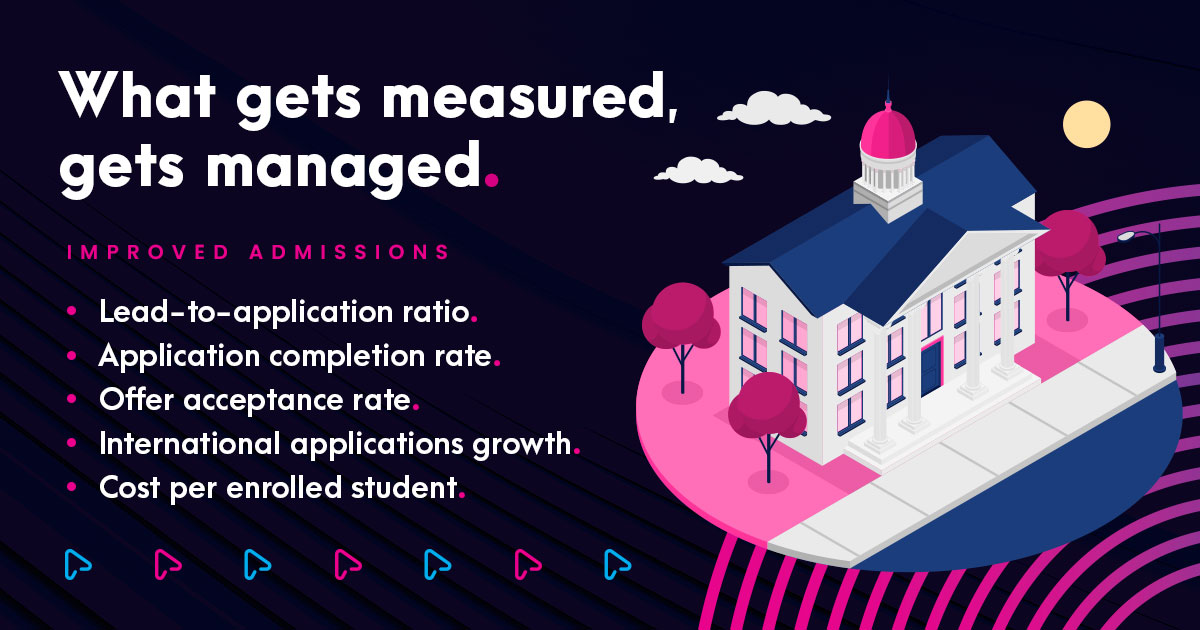Admissions teams face growing pressure to achieve enrollment goals, particularly with the increasing importance of international student recruitment. Tracking and improving the right Key Performance Indicators (KPIs) will transform how your admissions office operates. By focusing on these metrics, you can streamline your process based on real data.
In this blog, we’ll walk you through the top 10 KPIs every admissions office should track in 2025 and show you how DreamApply improved them.
Top 10 KPIs every admissions office should track in 2025
1. Marketing channel efficiency
This KPI evaluates the ROI of each recruitment channel.
Calculation formula: (Number of enrolled students via channel / Total investment in channel)
It identifies which marketing channels deliver the best value for your investment. A low efficiency score indicates misallocated resources or poor targeting.
Tip: Regularly analyze campaign performance and reallocate resources to high-performing channels like social media or email campaigns. Consider breaking this metric down by population (e.g., freshmen, transfer, international students) to understand which channels work best for each group.
2. Application processing speed
Application processing speed measures the average time taken to review and decide on applications.
Calculation formula: (Total processing time / Number of applications)
A faster processing speed demonstrates operational efficiency and improves applicant satisfaction, while delays increase drop-off rates.
Tip: Automate repetitive tasks like document verification or scoring to shorten processing times.
3. Lead-to-application ratio
The lead-to-application ratio measures the percentage of leads that proceed to start an application.
Calculation formula: (Number of started applications / Total number of leads) × 100
This KPI reflects how effectively your marketing and outreach efforts convert prospective students into active applicants. A low ratio might indicate unclear calls to action or messaging that doesn’t address applicant concerns.
Tip: Refine marketing messages to address common applicant concerns and include engaging calls to action. Hosting webinars and open houses can also help.
4. Application completion rate
This measures the percentage of applicants who successfully complete their applications after starting them.
Calculation formula: (Number of completed applications / Number of started applications) × 100
A high completion rate indicates a user-friendly and intuitive application process, while a low rate suggests friction points like complex forms or unclear instructions.
Tip: Simplify application forms, include progress-saving options, and send reminders to applicants who abandon their forms to boost completion rates.
5. Offer acceptance rate
The offer acceptance rate tracks the percentage of offers that result in confirmed enrollments.
Calculation formula: (Number of accepted offers / Total number of offers) × 100
This KPI reflects how compelling and well-communicated your offers are. A low rate may indicate poor timing, unclear program value, or lack of financial incentives.
Tip: Personalize offers by highlighting program benefits, scholarships, or career prospects to make them more appealing.
6. Conversion rate
Conversion rate measures the percentage of leads who ultimately enroll as students.
Calculation formula: (Number of enrolled students / Total number of leads) × 100
This metric demonstrates the overall effectiveness of your admissions funnel, from marketing to enrollment. A low conversion rate suggests inefficiencies in nurturing leads.
Tip: Identify and address bottlenecks in the enrollment process, such as delayed follow-ups or lack of personalized communication.
7. Offer acceptance time
Offer acceptance time measures the average time it takes for applicants to accept or decline an offer after it is sent.
Calculation formula: (Total offer response time / Number of offers)
Shorter acceptance times reflect clear and persuasive communication, while longer times may indicate applicant uncertainty or hesitation.
Tip: Add urgency by including deadlines or incentives, such as early-bird discounts, to encourage faster decisions.
8. Cost per enrolled student
Cost per enrolled student calculates the total recruitment expense per enrollment.
Calculation formula: (Total recruitment cost / Number of enrolled students)
This metric highlights the cost-effectiveness of your recruitment strategies. High costs often indicate inefficiencies or reliance on ineffective channels.
Tip: Focus on cost-efficient strategies like referrals and targeted online campaigns to reduce expenses without sacrificing results.
9. International student applications
This metric tracks the proportion of international applications compared to your total applicant pool.
Calculation formula: (Number of international applications / Total number of applications) × 100
It reflects how effectively your institution attracts international students. A low proportion could signal gaps in outreach, language barriers, or visa-related challenges.
Tip: Offer multilingual application forms, visa guidance, and region-specific financial details to appeal to international applicants.
10. Fee collection efficiency
Fee collection efficiency tracks how effectively institutions manage application fee payments.
Calculation formula: (Total fees collected / Total fees due) × 100
It highlights how smoothly your payment processes operate. Low efficiency may point to limited payment options or lack of timely reminders.
Tip: Streamline fee collection with automated reminders and offer multiple payment options to reduce delays.

How DreamApply helps improve these KPIs
DreamApply has empowered over 300 educational institutions globally to achieve remarkable results, including a 30% increase in student enrollment, a 40% reduction in time spent on admissions, and a 50% increase in international applications. Here’s how DreamApply can help you improve each KPI:
1. Optimizing marketing channel efficiency
DreamApply’s UTM tracking and ROI analysis identify the most effective marketing channels, helping you focus resources where they’ll have the greatest impact.
2. Accelerating application processing speed
DreamApply automates scoring, ranking, and bulk processing, significantly reducing review times and ensuring prompt responses.
3. Improving lead-to-application ratios
DreamApply integrates with marketing tools like HubSpot and Google Analytics to provide actionable insights into lead behavior. This helps refine campaigns and drive higher engagement rates. Read more about personalization in recruitment.
4. Boosting application completion rates
With adaptive application forms tailored to each applicant’s profile, DreamApply ensures a smoother experience. Progress-saving features and automated reminders help applicants complete their forms.
5. Increasing offer acceptance rates
Personalized offers crafted through DreamApply’s tools emphasize program benefits, scholarships, and fast-tracked processes, making them more appealing to applicants.
6. Enhancing conversion rates
DreamApply tracks drop-off points in the admissions funnel and automates personalized follow-ups, re-engaging applicants at critical stages.
7. Reducing offer acceptance time
With DreamApply’s two-way messaging, institutions can send timely follow-ups, offer details, and deadline reminders to encourage faster decisions. Explore what works best for recruiting students globally.
8. Lowering cost per enrolled student
By automating administrative workflows and reducing manual processes, DreamApply makes recruitment more cost-efficient.
9. Scaling international applications
With multilingual support, localized fee structures, and visa tools, DreamApply helps institutions like Padua University attract more international students.
10. Improving fee collection efficiency
DreamApply simplifies fee collection with automated reminders and integrates multiple payment gateways to ensure smooth transactions. Learn more in this article.
What gets measured, gets managed. Start tracking your KPIs today.
Tracking these KPIs can transform your admissions process, but improving them requires the right tools. With DreamApply, you’ll gain a powerful admissions platform that simplifies processes, engages applicants, and drives better results.
💡 Ready to improve your admissions strategy? Request a free demo or a tailored strategy booster plan with actionable insights specific to your institution’s goals
About DreamApply
Founded in 2011 in Estonia, DreamApply is an innovation-driven EdTech organization that improves access to education around the globe. DreamApply’s admissions software helps more than 300 educational institutions across 40 countries improve admissions, marketing, financial and other internal processes.
DreamApply’s easy-to-use and customizable software increases student enrollment by 30% and reduces application processing time by 40%. With features designed with and for educational institutions, and integrations with commonly used systems, DreamApply empowers teams to get more done with less effort.
Request a live walk-through of DreamApply with an expert.

